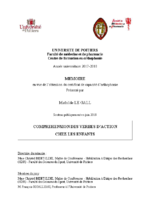Mémoire
Le gall Mathilde
Compréhension des verbes d'action chez les enfants
FrançaisConsulter le texte intégral (format PDF)

Résumé
Français
Compréhension des verbes d'action chez les enfants
L’évolution des théories sur la compréhension du langage a suscité un intérêt pour une perspective plus incarnée du langage. Nous présenterons les nombreuses preuves de l’existence d’un lien action-langage chez l’adulte, illustrant ainsi le rôle fondamental du corps dans la cognition. Cependant, peu de littérature apporte un éclairage sur ce lien chez les enfants. Ce travail de recherche avait donc pour objectif de mettre en évidence la trajectoire développementale du lien action-langage chez les enfants et de prouver son automatisation. Notre hypothèse était que le lien action-langage se développe progressivement par des expériences associatives et se renforce avec l’âge. Une tâche implicite d’activation des représentations sensori-motrices, réalisée auprès de trois classes d’âge, a montré l’existence d’un effet de congruence, preuve du lien action-langage, à partir de la classe de CE2, qui est stable jusqu’en CM2. Dans la discussion, une réflexion sur les possibles explications de l’absence d’automatisation du lien action-langage, chez les enfants de grande section a été menée. Un manque de reconnaissance de verbes et de précision motrice n’entraînerait pas l’absence de ce lien. De même, l’innéité du lien dont l’activation dépendrait de la maturation biologique ne serait pas une explication satisfaisante. Finalement, un manque d’associations répétées entre l’action motrice et le traitement des mots pourrait justifier le fait que le lien action-langage ne soit pas encore établi chez les enfants en grande section. Par ailleurs, ce travail permet de s’intéresser à des méthodes de rééducation utilisant l’action pour la prise en charge des troubles du langage en orthophonie.
Mots-clés libres : lien action langage, verbe d’action, représentations sensori-motrices, développement, neurones miroirs, apprentissage associatif.
- Enfants -- Langage
- Langage -- Compréhension
- Psychologie de l'apprentissage
- Activité motrice chez l'enfant
- Activité motrice
English
The evolution of the theories on the language comprehension aroused an interest for a more incarnated perspective of the language. Here we present the numerous proofs of the existence of an action-language link in adults, thus illustrating the fundamental role of the body in cognition. However, little literature shed light on this link in children. The aim of this research work is therefore to highlight the developmental trajectory of the action-language link in children and to prove its automation. Our hypothesis was that the action-language link develops gradually through associative experiences and increases with age. An implicit task of activation of sensorimotor representations, carried out with three age groups, showed the existence of a stable congruence effect, from Year 4 towards Year 6 class, proving then the action-language link. In the discussion, a reasoning on the possible explanations for the lack of link automation for children in last year of nursery school was directed. A lack of recognition of verbs as well as motor precision would not be responsible for the absence of this link. In the same way, the innateness of the link whose activation depends on the biological maturation would not be a satisfactory explanation. Finally, a lack of repeated associations in motor action and words processing could justify the fact that the action-language link is not yet established for children in last year of nursery school. In addition, this work allows for the using of rehabilitation methods using action for the care of language disorders in speech therapy.
Keywords : link action-language, action verb, sensorymotor representations, developpement, mirror neurons, associative learning.
Notice
- Diplôme :
- Orthophonie 5 (2017)
- Établissement de soutenance :
- Université de Poitiers
- UFR, institut ou école :
- UFR Médecine et Pharmacie
- Domaine de recherche :
- Orthophonie
- Directeur(s) du travail :
- Christel Bidet
- Date de soutenance :
- 19 juin 2018
- Président du jury :
- François Rigalleau
- Membres du jury :
- Christel Bidet
Menu :
-
-
à propos d'UPétille
-
Voir aussi
Annexe :

-
Une question ?
Avec le service Ubib.fr, posez votre question par chat à un bibliothécaire dans la fenêtre ci-dessous ou par messagerie électronique 7j/7 - 24h/24h, une réponse vous sera adressée sous 48h.
Accédez au formulaire...
Université de Poitiers - 15, rue de l'Hôtel Dieu - 86034 POITIERS Cedex - France - Tél : (33) (0)5 49 45 30 00 - Fax : (33) (0)5 49 45 30 50
petille@support.univ-poitiers.fr -
Crédits et mentions légales
